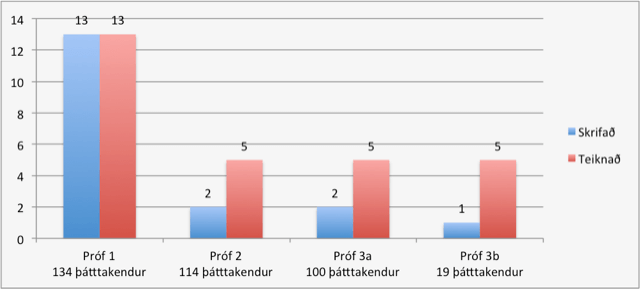Ottarsdottir’s 2000 study was the first comprehensive research project that systematically compared the impact of drawing and writing on memory functions. To the best of knowledge, it remains the only study which has been conducted in the world on such long-term memory of drawing and writing. The memory drawing study is therefore a milestone in the history of art therapy, education, psychology and psychotherapy.
In the year 2000, 134 children aged between 9 and 14 participated in a quantitative research where the impact of drawing on memory was studied. A comparison was made between memorizing words which were written and word content that was drawn.
The results showed that the children generally recalled an equal number of written words and drawings when asked to recall immediately after memorization. However, three weeks after the task had been completed, the children generally recalled two and a half times more drawings than written words. Nine weeks later, 19 of the 134 participating children were asked to recall the words, and this time they remembered generally five times more drawn words than written words. To the best of knowledge, this is the only worldwide study to date that has made comparisons between memory of drawn images and written words over such an extended period of time.

Five secondary school students who were dealing with specific learning difficulties and had experienced stress and/or trauma participated in a qualitative case study. A grounded theory approach was applied when analysing the data. The aim was to develop, design, study and test an art therapy method which facilitates children's coursework learning and emotional well-being. Memory drawing comprises part of the methods of art educational therapy. The study indicated that memory drawing can help students remember various aspects of diverse coursework subjects, such as spelling, translations of foreign words and facts, for instance in relation to geography. In addition to indications that showed the way in which memory drawing can aid students’ memorization of coursework subjects, the qualitative case study also demonstrated ways in which memory drawings can help an individual process emotions relating to difficult experiences in the same way as art making does in art therapy in general.
The theories and methods of art therapy are important for understanding and defining the memory drawing process, especially in the case of children who have experienced trauma and have insufficient support in their lives. As the drawing can bring sensitive emotions to the surface, it is essential that the therapist/teacher has specific understanding and knowledge of the art-making process and the importance of providing emotional support for the individual who is drawing.
References
Ottarsdottir, U. 2018 Processing Emotions and Memorising Coursework through Memory Drawing. ATOL: Art Therapy OnLine, 9(1).
Ottarsdottir, U. 2019 Ethical Concern when Applying Drawing for Memory: Research Conducted in Iceland. In: Audrey Di Maria (Ed.). Exploring Ethical Dilemmas in Art Therapy:50 Clinicians From 20 Countries Share Their Stories (pp. 266-272). New York: Routledge.
Ottarsdottir, U. (2020). Elaborare emozioni e memorizzare attraverso il disegno (memory drawing) [Processing Emotions and Memorising Coursework Through Memory Drawing]. (M. D. Cagnoletta, C. Corlatanu, S. Cosimini, S. Musolino, V. Nicholls, Trans.) (Original work published 2018). ATOL: Art Therapy OnLine, 11(1).